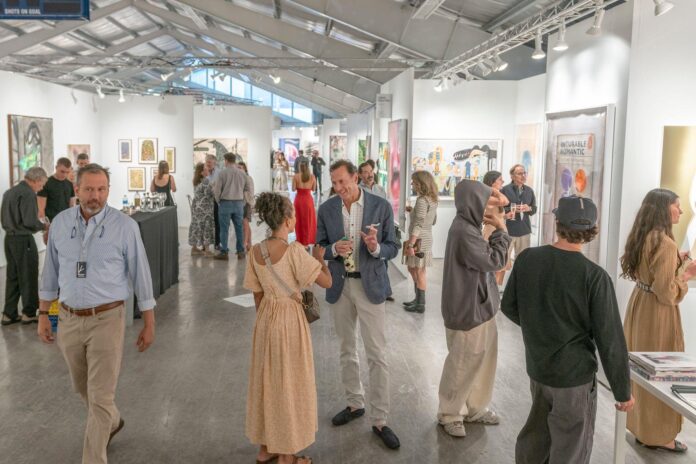The Intersect Aspen fair (until 4 August) has returned to the Aspen Ice Garden, a skating rink that transforms into a bustling recreation center during the ski town’s temperate summer months, for its third edition under its current structure. (The fair’s predecessor, Art Aspen, launched in 2010.)
The fair coincides with Aspen Art Week, a programme of performances, talks and exhibitions spearheaded by the Aspen Art Museum, including its annual ArtCrush benefit auction (4 August), a highly anticipated event among local collectors. As Aspen’s only fine art and design fair, Intersect has thrown its current focus behind community connectivity and fresh new voices, foregrounding formalism with bold, bright and tactile elements.

Visitors at the 2023 edition of Intersect Aspen Courtesy Intersect Aspen
The fair features 31 galleries from 27 cities this year, ten of which are showing at the fair for the first time. In addition to a slew of events for VIPs and day pass holders alike, Intersect has introduced a new curatorial initiative, the special projects segment, which features three artistic interventions created specifically for the fair. These projects are among the most explicitly political works on view at Intersect, and include Micro Mansion, an installation by local artist Chris Erickson that takes on the housing crisis in surrounding Roaring Fork Valley, and a hanging sculptural work by artist Aljoscha that comments on Russia’s war against Ukraine.
The fair’s arrival in the glamorous mountain environs of Aspen brings with it a concerted emphasis on material transformation. Intersect, as the name implies, spotlights the overlap between fine art and design, providing a perfect stage for saturated colour, decorative paintings and mid-size sculptural works brimming with textured technicality.

Amanda Martínez, Señal, 2022 Courtesy of the artist and Hesse Flatow, New York
At the stand of New York gallery Hesse Flatow, Señal (2022), a quiet, stately piece by Brooklyn-based artist Amanda Martínez, typifies this fair-wide investment in the procedural aspects of art-making. “She carves industrial foam in pieces and then adheres them together—it’s all by hand, but they are so precise they almost look laser-cut,” says gallery manager Rana Saner. “This clay, adobe colour palette really speaks to her Mexican heritage”. The piece also incorporates enamel, shredded tire rubber and pigmented stucco, layers of fabrication that lend a mystical richness to its ceremonial precision.

Natasha Das, Object 2, 2023 Courtesy Marc Straus Gallery
Marc Straus Gallery, another New York mainstay, is showcasing an exceptional selection of painstakingly rendered, hyperrealistic oil reliefs of ornamental rugs by Antonio Santín. “Each piece takes about eight months,” says gallery director Aniko Erdosi, “but those eight months are the result of ten years of perfecting his technique.”
Just a few feet away hang some small but dynamic fiber pieces (priced in the $4,200 range) by Indian American artist Natasha Das; the artist re-frames needlepoint as abstract brushstrokes, creating spatial depth through palpable gesture. “She’s a really good colourist, painting with fibers, essentially,” Erdosi says. “These pieces have an immediacy and playfulness to them.”

José Bedia, Wayom Lemond, 2023 Fredric Snitzer Gallery
This insistence on specificity is echoed at Miami-based Fredric Snitzer Gallery’s stand, which houses an arresting graphic sketch on Amate paper by Cuban painter José Bedia. Wayom Lemond (2023), priced in the $20,000 range, references The Kingdom of This World (1949), the historical novel about Haitian Independence by Cuban-French author Alejo Carpentier.
The piece reimagines the revolutionary struggle of rebellion leader François Mackandal as a phantasmagorical topography of cultural unrest. Amate paper, a traditional Mexican paper handmade from Amate and Mulberry trees, was outlawed during the Spanish conquest due to its association with magic and witchcraft, as the invaders sought to convert Indigenous populations to Catholicism. “I particularly love this work because there’s so much detail involved and so many different elements,” says gallery director Josha Veasey. “Every time you look at it, you see something you didn’t see before.”

Rachel Garrard, Apex, 2023 Hexton Art Gallery
The stand of Aspen-based Hexton Gallery includes two paintings by nomadic artist Rachel Garrard, whose meditative abstractions merge the wonder of the natural world with a hard-edged approach to composition. Her dreamy gradients are composed with hand-crushed pigments collected from her immediate environment, like quartz, ash or rock powder.
“Rachel is really all about grounding us, and it’s done in a spiritual way and a physical way,” says gallery director Robert Chase. “She paints in areas she feels really connected to—Tulum is a big one for her—and she creates symbollic images that make us think about who we are and where we come from.”
- Intersect Aspen, until 4 August, Aspen Ice Garden, Aspen, Colorado

























